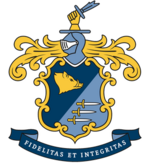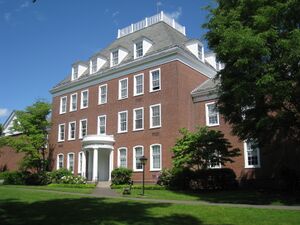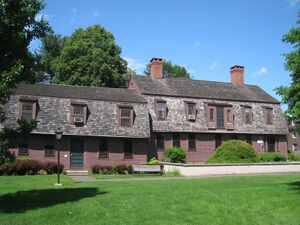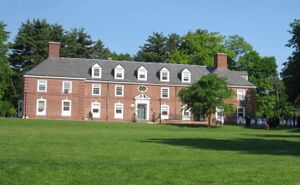تشوات روزماري هال
| Choate Rosemary Hall | |
|---|---|
 | |
| العنوان | |
333 Christian Street ، Connecticut 06492 الولايات المتحدة | |
| الإحداثيات | 41°27′28″N 72°48′35″W / 41.45766°N 72.80973°W |
| معلومات | |
| أسماء أخرى | Choate |
| النوع | Private, college-preparatory boarding school |
| Motto | لاتينية: Fidelitas et Integritas (Fidelity and Integrity) |
| تأسست | 1890 |
| تأسست | 1890 |
| المؤسسون |
|
| CEEB code | 070810 |
| NCES School ID | قالب:NCES Private School ID |
| Head of school | Alex Curtis |
| Teaching staff | 121.4 قالب:FTE[1] |
| Grades | 9–12 |
| Gender | Co-educational |
| Enrollment | 850 (2017–2018)[1] |
| Student to teacher ratio | 7.1[1] |
| Campus size | 458 acres (185 ha) |
| Campus type | Suburban |
| Color(s) | Choate blue, gold, rosemary blue |
| Athletics conference | |
| Mascot | Wild boar |
| Newspaper | The Choate News |
| Yearbook | The Brief |
| Endowment | $396 million (2022)[2] |
| Affiliations | |
| Website | www |
Choate Rosemary Hall (often known as Choate; /tʃoʊt/[3]) is a private, co-educational, college-preparatory boarding school in Wallingford, Connecticut, United States. Founded in 1890, it took its present name and began a co-educational system with the 1971 merger of The Choate School for boys and Rosemary Hall for girls. It is part of the Eight Schools Association and the Ten Schools Admissions Organization.
التاريخ
السنوات المبكرة
The Choate School and Rosemary Hall were both founded by prominent New England families, the Choates and Atwaters.[4]
روزماري هال
Rosemary Hall was founded in 1890 by Mary Atwater Choate at Rosemary Farm in Wallingford, her childhood home and the summer residence of her and her husband, William Gardner Choate. Mary, an alumna of Miss Porter's School, was the great-granddaughter of Caleb Atwater (1741–1832), a Connecticut merchant magnate who supplied the American forces during the Revolutionary War.
In 1888, Mary Atwater Choate advertised in The New York Times for a headmistress to run a school that would train girls in the "domestic arts." The advertisement was answered by Caroline Ruutz-Rees (1865–1954), a 25-year-old Briton teaching in New Jersey.[5] The school opened in 1890. The first eight students occupied the "old" Atwater House.
Caroline Ruutz-Rees would later change Rosemary Hall's mission from "domestic arts" to that one similar of a contemporary boys' school.
مدرسة تشوات
The Choate School was also founded by William and Mary Choate in 1896. William Gardner Choate (1830–1921) was U.S. District Judge for the Southern Circuit of New York from 1878 to 1881, and afterward a partner of Shipman, Barlow, Laroque, and Choate. He was a national authority on railroad, bankruptcy, and corporation law.[6]
William and Mary Choate invited their tenant, Mark Pitman (1830–1905), to start a boys' school under their sponsorship. Pitman had been principal of Woolsey School in New Haven, Connecticut.[7] He accepted the Choates' offer and employed his daughters, Leila, Elizabeth, and Helen.
Six boys, with the average age of 10, entered the new school in fall term 1896. Pitman taught Latin, English, history, and science, while Pitman's daughters Elizabeth taught art, Helen piano, and Leila was a writing teacher and school nurse. Mary Choate's brother, Huntington Atwater, taught crafts and was the school doctor.
There was no formal relationship at the time with Rosemary Hall – a hundred yards to the school's east on Christian Street – but there were coeducational audiences for plays and recitals and Mary Choate hosted dances at the Homestead.
The St. John Years
In 1908, George St. John (1877–1966), an Episcopal priest, became head master of Choate. He had taught at The Hill School in Pennsylvania and Adirondack-Florida School, and was teaching at Hackley School in Tarrytown, N.Y., when he was recruited for the headmastership.
St. John and his wife, "signed with the Choates an 'Agreement to Lease and Purchase'. Under its terms, the young couple rented the school, its property and reputation, for five years at a sum equal to 11 percent of The Choate School's net income per year. ...Less than twenty months later, on May 12, 1911, St. John reported to the trustees that he had purchased the title to the school by acquiring mortgages of roughly $41,000. He resold the title in turn to The Choate School, Incorporated, for $23,000 cash and $38,000 in stock ... For all intents and purposes, The Choate School belonged to George St. John."[8]
In his first quarter-century as headmaster, St. John created much of Choate as it is regarded today. Of the Georgian brick and stone campus, he had built, by 1932, Hill House, West Wing, the Gymnasium, Memorial House, the Chapel, the Library, the Winter Exercise Building, and Archbold Infirmary, which was the largest school infirmary in the country. He grew the enrollment from 35 to 505 boys and the faculty from 5 to 64 masters. In the decade following the First World War, Choate sent 412 of its 618 graduates to Yale, Princeton, and Harvard, according to a table published in The Choate News in fall term 1928.[9]
George St. John belonged to a generation of long-serving headmasters who shaped New England prep schools, chief among whom were Endicott Peabody of Groton School, Frank Boyden of Deerfield Academy, Horace Dutton Taft of Taft School, Frederick Sill of Kent School, Samuel Drury of St. Paul's School, Alfred Stearns of Phillips Academy Andover, Lewis Perry of Phillips Exeter Academy, and George Van Santvoord of Hotchkiss School.[10]
Choate was succeeded in 1947 by his son, Seymour St. John '31 (1912–2006), and the "St. John dynasty" continued to 1973. The younger St. John oversaw the construction of more buildings, broadened the curriculum, and raised the national profile of the school.
Seymour St. John was a longtime advocate of coeducation and initiated the Choate-Rosemary contacts. At his death, headmaster Edward Shanahan told the New York Times, "[t]he merger demanded an enormous expenditure of resources by Choate because the building of a new campus was to occur within the footprints of its property. Seymour was central to the decision to expand those resources."[11]
JFK, the Muckers, and "Ask not"

In 1931, John F. Kennedy entered Choate as a third form (9th grade) student, following his older brother Joe Jr., who was a star athlete at the school.
Jack Kennedy—sickly, underweight, and nicknamed Rat Face by his schoolfellows—spent his first two years at Choate in his brother's shadow, and compensated for it with rebellious behavior that attracted a coterie. He named his group The Muckers Club, which had thirteen members—Kennedy and twelve disciples. Among these was Kennedy's lifelong friend Kirk LeMoyne "Lem" Billings, who kept an apartment in the White House during JFK's presidency.[12]
Kennedy graduated from Choate in 1935. In senior class polling for the yearbook (of which he was business manager), he was voted 'Most Likely to Succeed'.
It has been suggested that the oft-remembered quote from Kennedy's inauguration may have originated from a common refrain from Choate headmaster, George St. John's chapel talks: "The youth who loves his alma mater will always ask not 'What can she do for me?' but 'What can I do for her?'".[13]
Sexual abuse scandal
In 2017, the school acknowledged a decades-long sex abuse scandal, with multiple victims being subjected to abuse from many different faculty and staff members. A report commissioned by the school documented dozens of students who had suffered abuse, dating from the 1960s through the 2010s; the most incidents were reported to have taken place in the 1980s.[14][15]
Academics
Curriculum
Choate's curriculum includes elective and interdisciplinary courses, from astronomy and architecture to printmaking and post-modernism to digital video and development economics.[16] There are more than 300 courses in the curriculum, which has requirements in community service and in contemporary global studies. All disciplines except English have honors courses.
Signature programs
The Choate signature programs include the Advanced Robotics Program, Arabic and Middle Eastern Studies, Arts Concentration, Capstone, Environmental Immersion Program, JFK Program in Government and Public Service, Science Research Program, and the Global Education Program.[17]
Musical appearances
The Choate chamber orchestra performed at the White House in December 2009 and the school's symphony orchestra toured Europe in 2010 and 2011, giving concerts in ten countries. The festival and chamber choruses performed at St. Patrick's Day mass at St. Peter's Basilica in Rome in 2011.[18]
Choate orchestras and choral groups toured East Asia in 2000, 2005, 2007, and 2014. The June 2014 tour comprised concerts in Seoul, Hong Kong, and Macau, at the Great Wall at Ju Yong Guan, and in ensemble with the Concert Band of Beijing Children's Palace. Choate orchestras have also performed at Lincoln Center in New York, Carnegie Hall, and the Guggenheim Museum.
The school's student-operated radio station, WWEB, was FCC-licensed and founded in 1969.[19]
Specialized programs
The Senior Project Program provides on- or off-campus internships in academic research, visual art, and the performing arts.
Other specialized programs include American Studies, creative writing, economics, FBLA, mathematics, philosophy, psychology, religion, debate, and the Fed Challenge. The 2011–12 academic year saw the introduction of an Arabic and Middle Eastern Studies Program (AMES).[20] Choate's Office of Global Studies supports study-abroad and other international initiatives. One-third of Choate students participate in programs in China, France, Japan, Spain, and Jordan.[21]

Environmental Center
The Kohler Environmental Center, designed by Robert A.M. Stern Architects, opened in 2012 and is located on a 268-acre site in the northeast quadrant of the campus. It has been described as "the first teaching, research and residential environmental center in U.S. secondary education."[22]
STEM
In February 2015, the school opened the Lanphier Center for Mathematics and Computer Science, a 35,000-square foot campus hub for information technology, applied mathematics, and robotics. The center, designed by Pelli Clarke Pelli, contains laboratories, classrooms, a lecture hall, and common spaces.[23]
National Fed Challenge
Choate's Fed Challenge team was the 2009 national champion and has won the New England District Championship in 12 of the past 13 years.[when?] In the 2012 American Mathematics Competitions (AMC) 12-A, Choate's team finished first in the nation, with the highest combined score of all 2631 participating schools.[24][Note 1]
استخدام التكنولوجيا
In 2012, Choate became the first among its peer preparatory schools to require that all faculty and students own an iPad. The fall term that year saw the beginning of full integration of the tablet's capabilities into the syllabus. Choate's director of academic technology discussed Choate's iPad program in an August 2012 article in US News.[25]
پروفيل إحصائي
التسجيل
Choate enrolls 861 students, has 120.4 full-time equivalent teaching staff, and a student-teacher ratio of 7.0 for the 2023-2024 school year.[1]
المساعدة المالية
Financial aid totaling more than $10 million was awarded to 32 percent of the student body, the average award being $38,000 for boarders and $26,000 for day students.[26][27]
Among member institutions of the Eight Schools Association, Choate led in gifts from parents, with $2.1 million. Total gifts received in that fiscal year were $28.9 million.[28] In November 2006, the school inaugurated a capital campaign with a target of $200 million and, by the campaign's close in 2011, gifts and pledges of $220 million had been secured.[29]
Religious profile
Protestant, Catholic, Jewish, and Muslim chaplains serve Choate's campus ministry.[26]
Extracurricular activities
Athletics

Choate competes in sports against schools from all over New England and adjacent states. Teams are fielded at the levels of varsity, junior varsity, and thirds sections. There are 32 different sports and 81 teams in interscholastic competition.[30] Intramural programs include aerobics, dance, senior weight training, yoga, winter running, rock climbing, fitness and conditioning, and senior volleyball.
In 2007 to 2016, Choate won New England championships in football, boys and girls ice hockey, girls' soccer, boys' golf, boys' crew, and in girls' swimming, volleyball, and water polo. In that same period, Choate won Founders League championships in boys' and girls' squash, in boys' cross country, golf, softball, and tennis, and in girls' volleyball.[31]
The athletic directors of Choate and the other members of the Eight Schools Association compose the Eight Schools Athletic Council, which organizes sports events and tournaments among ESA schools.[32][33][34] Choate is also a member of the New England Preparatory School Athletic Council (NEPSAC) and the Founders League, which comprises private schools located mainly in Connecticut.
Choate–Deerfield rivalry
Along with similar boarding school traditions including the Andover–Exeter rivalry and Hotchkiss-Taft rivalry, Choate and Deerfield Academy have a parallel sports rivalry on spirit week.[35]
Historic cricket match
In 1893, Rosemary Hall were host to a cricket match with Mrs. Hazen's School of Pelham Manor, N.Y., that has been described by some as "the first interscholastic girls sporting event in American history."[36] [37]
Publications
Gertrude Stein and The Lit
In 1935, Gertrude Stein gave a series of talks across the country that included a visit to Choate on January 12 and 13.
In the audience was stenographer, Dudley Fitts, a critic, translator, and longtime teacher of Greek and Latin at Choate. Stein's public speaking style was extemporary, and Fitts made a stenographic transcript. After an exchange of letters, Stein authorized Fitts to oversee publication of her talk in The Choate Literary Magazine.[38]
Stein's essay appeared in the February 1935 issue of The Lit with the title "How Writing Is Written." It has many times since been anthologized and given academic treatment, with the Choate text unaltered. It "occupies a unique place in Stein's corpus as a social text that carries the marks of its particular occasion ... direct address to her audience (around sixty boys, as well as faculty and some former students)."[39]
Stein's two-day stay at Choate was her first self-acknowledged exposure to a private school. In her 1937, Everybody's Autobiography, Stein wrote, "It was the first time I had ever seen such a school. When I was brought up in East Oakland[,] we all went to public school ... The boys from twelve to sixteen listened[,] really listened[,] to everything I had to say ... I had been much struck by the Choate school literary magazine which did have extraordinary good writing in it."[40]
Edward Albee and The Lit
In 1944, future playwright, Edward Albee transferred from Valley Forge Military Academy to Choate. Admissions director Frank Wheeler remarked presciently, "I have a feeling he will distinguish himself in literature."[41]
Incidents from Albee's time at Choate are reworked for his plays.[42]
The May 1946 Commencement issue of The Lit contained Albee's first published play, Schism. Another play written at Choate, Each In His Own Way, went unpublished and forgotten until 1996, when a classmate preparing for their 50th reunion found it in a scrapbook.[43]
Notable alumni
Notes
- ^ To find this information, select "AMC 10/12 A 02/07/2012", then "AMC 12", then "School Honor Roll" as the query.
References
- ^ أ ب ت ث خطأ استشهاد: وسم
<ref>غير صحيح؛ لا نص تم توفيره للمراجع المسماةNCES - ^ "Choate Rosemary Hall Profile". The Association of Boarding Schools. Retrieved February 12, 2021.
- ^ Ben Zimmer (December 31, 2009). "Choate". The New York Times. Retrieved December 23, 2014.
- ^ Ephraim Orcutt Jameson, The Choates in America, 1643–1896 (Ipswich, Massachusetts, 1896); Charles Henry Stanley Davis, History of Wallingford, Conn. (Meriden, Conn., 1870)
- ^ Tom Generous, Choate Rosemary Hall: A History of the School (Wallingford, Conn., 1997), p. 3. Much of the matter in this section is taken from Generous.
- ^ "Memorial of William Gardner Choate", New York County Lawyers' Association Yearbook 1921 (New York, 1921), pp. 199–200
- ^ Obituary Record of the Graduates of Bowdoin College and the Medical School of Maine for the Decade Ending June 1, 1909 (Brunswick, Maine, 1911), pp. 350–1
- ^ Generous, op cit, p. 66
- ^ The Choate News, October 13, 1928, reproduced in Generous, op cit, p. 90
- ^ James McLachlan, American Boarding Schools: A Historical Study (New York, 1970), passim; Christopher F. Armstrong, "On the Making of Good Men: Character-Building in the New England Boarding Schools", in The High-Status Track: Studies of Elite Schools and Stratification, ed. P.W. Kingston and L.S. Lewis (Albany, N.Y., 1990), pp. 9–10
- ^ "Seymour St. John, 94, Leader of Choate School for 26 Years, Dies". New York Times. April 20, 2006.
- ^ Nigel Hamilton, JFK: Reckless Youth (Random House, 1992), pp. 88-101, 119-27; Robert Dallek, An Unfinished Life: John F. Kennedy, 1917–1963 (Little, Brown and Co., 2003), pp. 33-9; David Pitt, Jack and Lem: John F. Kennedy and Lem Billings: The Untold Story of an Extraordinary Friendship (Da Capo Press, 2008), passim
- ^ Time magazine, January 28, 1966; Parade magazine, December 15, 1968; Thurston Clarke, Ask Not: The Inauguration of John F. Kennedy and the Speech that Changed America (Henry Holt and Co., 2004), p. 78; Chris Matthews, "The Genesis of JFK's 'Ask Not' Line", The Blog, HuffingtonPost.com, January 20, 2011; Chris Matthews, Jack Kennedy: Elusive Hero (Simon & Schuster, 2011), pp. 23, 325-6, 441-2; "Document may shed light on origins of JFK speech", Associated Press, November 3, 2011
- ^ Harris, Elizabeth A. (April 13, 2017). "Sexual Abuse at Choate Went On for Decades, School Acknowledges". The New York Times. ISSN 0362-4331. Retrieved April 14, 2017.
- ^ Kestenbaum, Nancy (April 2017). Report to the Board of Trustees of Choate Rosemary Hall (PDF).
- ^ [1] Archived 2010-01-11 at the Wayback Machine; "Archived copy" (PDF). Archived from the original (PDF) on May 27, 2010. Retrieved February 27, 2010.
{{cite web}}: CS1 maint: archived copy as title (link) - ^ "Signature Programs". Archived from the original on 2016-08-15.
- ^ Choate Rosemary Hall Bulletin, Summer 2010, p. 6, and Summer 2011, p. 6
- ^ "Home - Choate Rosemary Hall | Private Boarding & Day School". www.choate.edu.
- ^ [2] Archived نوفمبر 30, 2011 at the Wayback Machine
- ^ Emma Zehner, "Arabic Abroad Program to be Launched in Summer 2012", The News, October 7, 2011
- ^ Interview with Dr. Howard R. Ernst, "Ernst Recruits Prospective KEC Participants", The News, October 7, 2011; "Choate Rosemary Hall: About Choate » Kohler Environmental Center". Archived from the original on November 27, 2011. Retrieved December 8, 2011.
- ^ "Q & A with Cameron and Edward Lanphier '74", Choate Rosemary Hall Bulletin, Winter 2015, pp. 8-9
- ^ "AMC Statistics". Mathematical Association of America. Archived from the original on 2012-12-05. Retrieved 2021-10-25.
- ^ Ryan Lytle, "Tablets Trump Laptops in High School Classrooms", U.S. News & World Report, August 3, 2012
- ^ أ ب "Choate Rosemary Hall: About Choate » Quick Facts". Archived from the original on 2010-01-07. Retrieved 2010-01-01.
- ^ [3][dead link]
- ^ "Choate on the Move: A Year in Review", Choate Rosemary Hall Bulletin, Winter 2015, pp. 11-13
- ^ "Choate Rosemary Hall Bulletin, Spring 2012, p. 8".
- ^ "Teams & Schedules". Archived from the original on May 27, 2010. Retrieved July 6, 2010.
- ^ Spencer Stuart, op cit, p. 4; Choate Rosemary Hall Bulletin, Summer 2010, p. 56
- ^ "Drive Time Radio (Sort Of) (As Far As You Know)". www.nedgallagher.com.
- ^ "A Lawrenceville Story (As Far As You Know)". www.nedgallagher.com.
- ^ "Meeting, Meeting, Meeting (As Far As You Know)". www.nedgallagher.com.
- ^ "Deerfield and Choate's Parallel Spirit-Week Traditions". 12 November 2021.
- ^ Tom Melville, The Tented Field: A History of Cricket in America (Bowling Green, Ohio: Bowling Green State University Press, 1998), p. 114
- ^ "Girls at the Wickets", The New York Times, November 14, 1896; "Girls Play Cricket", The Morning Herald (Baltimore), November 16, 1896, p. 6; "Women and Cricket", The Evening Telegram (St. John's, Newfoundland), June 27, 1898, p. 3; Melville, loc cit; Tom Generous, Choate Rosemary Hall: A History of the School (Wallingford, Conn., 1997); Venu Palaparthi, "1895 Cricket match between Mrs. Hazen's School and Rosemary Hall – A Historic First for Interscholastic Girls Sports", July 10, 2009, DreamCricket.com; Yale Medical Journal, vol. III, no. 1 (Nov. 1896), p. 46; Choate Rosemary Hall Bulletin, Spring 1964, p. 12
- ^ Gertrude Stein and Alice B. Toklas Papers, shelfmark 106.2109, Beinecke Rare Book and Manuscript Library, Yale University
- ^ Logan Esdale, "Contexts", in Gertrude Stein, Ida: A Novel (Yale University Press, 2012)
- ^ Robert Bartlett Haas, ed., How Writing Is Written (Los Angeles: Black Sparrow Press, 1974); A. Walton Litz, Louis Menand, and Lawrence Rainey, eds., The Cambridge History of Literary Criticism, vol. VII (Cambridge University Press, 2000), pp. 110-13; Gertrude Stein, Everybody's Autobiography (Random House, 1937), pp. 247-8
- ^ "Odd Man In" (cover story), Newsweek, October 10, 1966
- ^ Mel Gussow, Edward Albee: A Singular Journey: A Biography (Simon & Schuster, 1999), pp. 56, 158
- ^ Gussow, op cit, pp. 54-61
Further reading
- Cookson, Peter W., Jr., and Caroline Hodges Persell. Preparing for Power: America's Elite Boarding Schools (Basic Books, 1985) online
- McLachlan, James. American Boarding Schools: A Historical Study (1970) online
External links
 Media related to تشوات روزماري هال at Wikimedia Commons
Media related to تشوات روزماري هال at Wikimedia Commons- Official website
- The Association of Boarding Schools profile
قالب:Eight Schools Association قالب:The Ten Schools Admissions Organization قالب:Founders League
قالب:New England Preparatory School Athletic Council خطأ لوا في وحدة:Authority_control على السطر 278: attempt to call field '_showMessage' (a nil value).
- Pages using gadget WikiMiniAtlas
- Articles with dead external links from August 2017
- Short description is different from Wikidata
- Infobox mapframe without OSM relation ID on Wikidata
- Coordinates on Wikidata
- Articles containing لاتينية-language text
- Pages using Lang-xx templates
- Vague or ambiguous time from May 2015
- Articles with hatnote templates targeting a nonexistent page
- Official website different in Wikidata and Wikipedia
- Choate family
- Schools in New Haven County, Connecticut
- Private high schools in Connecticut
- Preparatory schools in Connecticut
- Boarding schools in Connecticut
- Buildings and structures in Wallingford, Connecticut
- Co-educational boarding schools
- Six Schools League
- Educational institutions established in 1890
- تأسيسات 1890 في كنتيكت
- صفحات مع الخرائط




